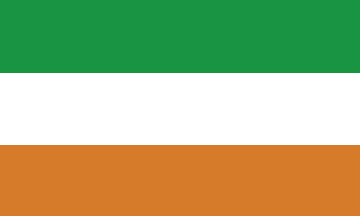h-01.gif) image contributed by Fred Drews, 27 March 2006
image contributed by Fred Drews, 27 March 2006
Last modified: 2020-04-19 by rob raeside
Keywords: heredia | barva |
Links: FOTW homepage |
search |
disclaimer and copyright |
write us |
mirrors
 image by Fred Drews, 25
March 2020
image by Fred Drews, 25
March 2020See also:
The municipality of Barva (40,660 inhabitants in 2011; 5,380 ha), forming
Canton No. 2 of the Heredia Province, is located 3 km north of the town of
Heredia. The canton is divided into six districts: Barva, San Pedro, San
Pablo, San Roque, Santa Lucía, and San José de la Montaņa. The main source of
income in Barva is agriculture, the two main products of the canton being
coffee and cow milk.
Barva was once part of the West Huetar Kingdom.
Cacique Barva (also known as Barvak or Barba) ruled the area limited by River Virilla
and mounts Aguacate, subsequently known as Barva Valley. A document dated
1569 relates that the region was inhabited by Catapa, Tice and Patica
Indians, who poorly lived from subsistence agriculture. The same year,
Governor Perafán de Ribera shared the Indians among two Spanish colonists,
Juan Romo (400 Indians) and Simón Sánchez (100 Indians). A first church,
dedicated to St. Bartholomew, was built between 1568 and 1575 on the site of
an Indian cemetery. Barva was listed in 1606 on the Cartago Protocols, with
Leandro de Figueroa as its ruler. A settlement named San Bartolomé de Barva
was established in 1613 around a Franciscan convent. Ruined by an
earthquake on 15 February 1772, the convent and the parish church were
re-established in the early 19th century, to be ruined again on 30 December
1888 by another earthquake.
The community quickly increased to 53
households in 1693, 575 inhabitants in 1699, 641 inhabitants in 1709, and 161
households in 1711, mostly Indians. The first Municipal Council of Barva met
on 7 August 1820. State Law No. 30 of 11 November 1824 granted the title of
"villa" to Barva, then known as Asunción de Barva. The title was increased to
"ciudad" by State Law No. 28 of 24 July 1918.
Barva is the birth place of
Colonel Nicolás Aguilar Murillo (1834-1898), a hero of the Campaign of
1856-1857 fought against William Walker, proclaimed a National Hero in 1892
(officially confirmed only on 30 September 2013), and of the lawyer and
historian Cleto González Víquez (1858-1937), President of the Republic
(1906-1910 and 1928-1932), who is portrayed on the municipal coat of arms.
http://www.munibarva.go.cr/ - Municipal website
The flag of Barva
is horizontally divided green-white-ochre.
Photo:
http://www.fotopaises.com/foto/Costa_Rica/Barva_de_Heredia/113187.html
Ivan Sache, 21 July 2014